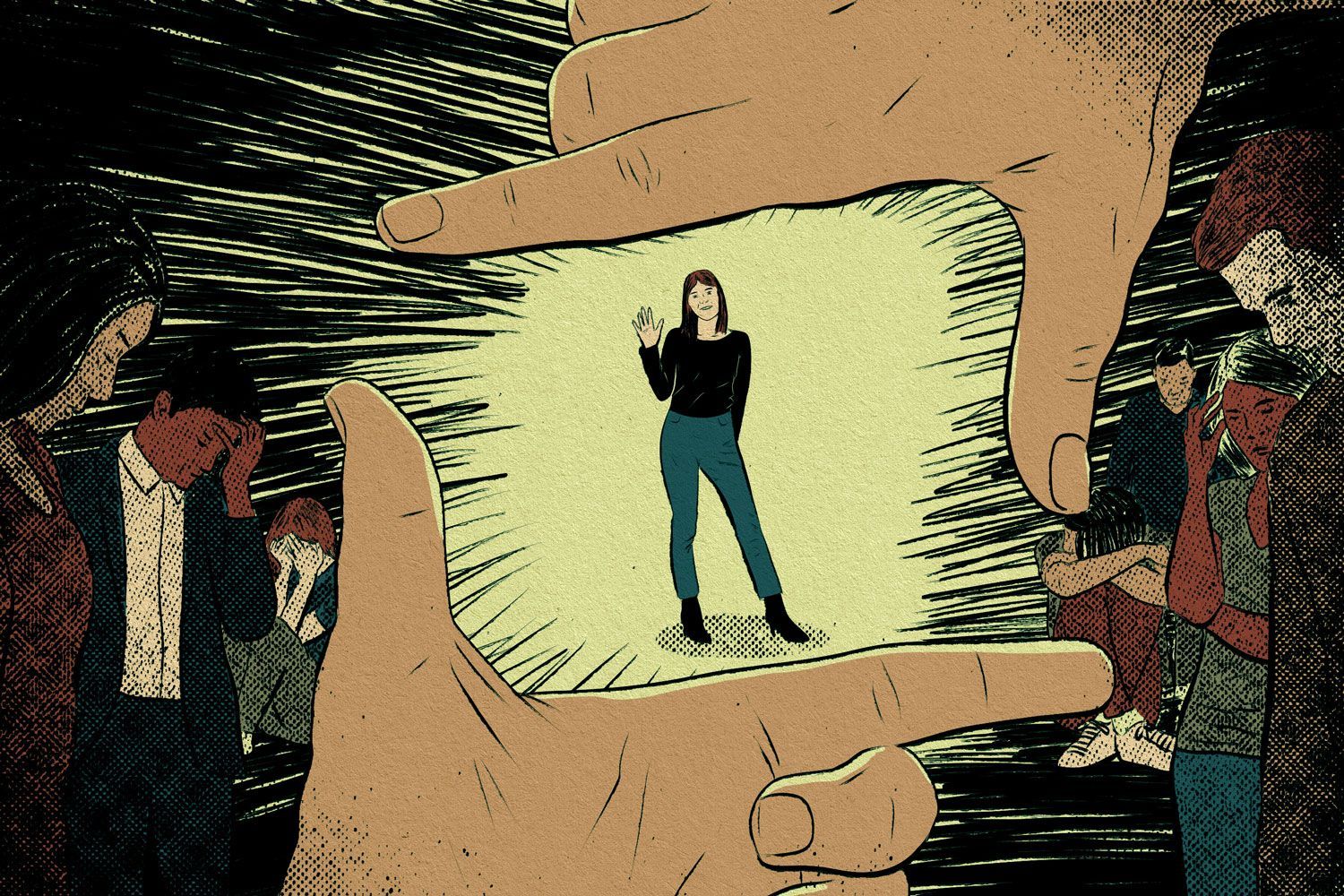The dark side of happy ever after
After years of doom and gloom, the media is slowly abandoning the more depressing cliches about mental illness. But do the alternative narratives fall into the same trap?

Illustration by Jarett Sitter.
Every year in Melbourne, in the week before the AFL Grand Final, you’ll find the same photo in the city’s tabloid paper—a couple of cute dogs dressed up in the competing teams’ club colours. Scarves, jumpers, perhaps a match day Sherrin tucked under a paw, beneath a headline so full of puns it could make your teeth itch. It’s a tableau that tells a not-so-subtle story: “Footy fever is here. This city’s so mad for it, even the animals are obsessed.”
Media tropes are shortcuts. They signify a broad message in the simplest, most familiar terms, so our brains make the connection without having to expend too much effort. In time-poor, resource-light newsrooms, they’re the kinds of formulaic page filler that make the job of being an editor a little bit easier. Want to tell your audience they’re in for a long hot summer? Reach for the stock photo of grinning teenagers in board shorts, leaping off a pier. Need a quick way to telegraph community unrest? Assemble a group of disgruntled locals, arms crossed, standing outside a construction site.
There was a time when mental illness was portrayed in similarly prosaic terms. A lone figure, silhouetted, cowering in the shadows. An anguished soul in a stairwell, head in hands. As someone who has lived with periods of anxiety and depression since I was a teenager, I always found these depictions confounding. It was part of how I lived, but it wasn’t all of it. Smiling my way through parties with no visible sign of my internal struggle was just as much a feature of my lived experience as all the days when I sobbed into my pillow and couldn’t get out of bed.
During my time as health reporter at The Age, I observed a gradual shift in how the media reported on the one in five of us who will experience a mental health condition in any given year. Public discourse around mental illness and suicide became more open, thanks in part to organisations like Mindframe, which helped educate journalists on responsible reporting, and which helped ensure a subject once neglected by editors gained more positive and prominent coverage. The shadowy images became less common as people living with mental illnesses—and the organisations that supported them—pointed out that these depictions were neither helpful nor accurate, and only served to entrench stigmatising stereotypes.
But in recent years it feels like the pendulum has swung too far in the opposite direction. Mental health has since been elevated to the mainstream, and media outlets are clamouring for mental health-related content. Only now they’re favouring feel-good stories of redemption, where people move seamlessly from sickness to cure. We’ve been brought out of the shadows, but the narrative still feels woefully reductive. The stories invariably follow the same formula: someone falls victim to a bout of depression or anxiety like catching a cold, they get some help, fight their way back to recovery, and are forever healed.
It’s a narrative that can make me feel like I am failing. My mental illness is episodic. Each time I cycle back to a place I thought I’d left behind, I wonder if perhaps I am broken. Why is everyone else on a direct path from unwell to recovered while I keep sliding backwards?
Short answer: because they aren’t.
Our psychological health is messy and complicated. It’s often characterised by two steps forward, one step back and a whole lot of standing still in that grey area in between. We might understand this better if we saw a more honest depiction of what mental ill health looks like for many people. An unvarnished view of the complexity and fallibility of the human brain would make those who struggle with recurring periods of psychological distress feel less alone. It would also help educate the public, fostering greater empathy and compassion, and go some way to informing more nuanced support and treatment responses.
But I get it. As a journalist and media adviser, I understand that complexity is difficult to sell to a shrinking, time-poor media. Journalists and comms strategists appreciate clean lines and neat narratives, and stories of triumph are simply easier to package into short grabs and snappy headlines than journeys that veer into more complicated terrain. These narrative templates—which you can see in everything from children’s stories to Hollywood movies to sporting folklore—feed into a broader cultural norm that encourages us to strive for the fairytale ending. A story arc that bends towards happiness and doesn’t bend back is how we’ve been conditioned to view success. It remains the dominant media narrative because storytellers believe—mistakenly in my view—that it’s what audiences want.
When we characterise anything divergent as a failing, we perpetuate the myth that backwards or sideways steps are an aberration.
But what we actually crave as humans is to be seen. Focusing only on the narrowest version of mental ill-health erases the lived experience of a large proportion of people who don’t fit neatly into boxes. It’s true that reporting of conditions such as anxiety and depression has reached a peak we might reasonably categorise as progress. But less common, more complex conditions such as schizophrenia, bipolar or borderline personality disorder remain in the shadows.
When we don’t tell these stories, or when we confine them to the margins, they stay shrouded in shame and ignorance. And that can help proliferate harmful stereotypes. For instance, it remains common in some sections of the media to draw a line between criminal acts and mental illness, despite evidence showing people living with mental ill-health are far more likely to be victims of crime than perpetrators.
Language and tone are important, too. When we celebrate the archetypal hero’s journey from crisis to recovery but characterise anything divergent as a failing or weakness, we perpetuate the myth that backwards or sideways steps are an aberration, rather than a normal feature of the mental health continuum. I want to see more non-linear media depictions. More nuanced stories that show that it’s possible to struggle and still be strong. A celebration of the human experience that colours outside the dichotomous lines of ‘mental illness: bad, wellness: good.’
We don’t have to imagine what such depictions might look like, though we do have to hunt for them. A few years ago, leading mental health organisation Beyond Blue produced a video in which a woman with a history of complex mental illness and suicidal ideation talked about the strengths that someone like her could bring to a workplace. (I work part-time as a contractor for Beyond Blue, but wasn’t involved with the production of this video.) In the film, the woman details how those who experience suicidality are often seen as weak or flaky, and can be marginalised at work as a result. She then points out that, in reality, people who have fought for their lives are some of the most resilient and resourceful people in our community. Not because they’ve moved from the shadows into the light, but because they have the strength and the skills to live in the grey. We need mainstream media to tell more stories like these.
Showcasing richer, more complex stories is not without its challenges, but there’s arguably never been a more important time to try. The mental health tail of the COVID crisis will be long, and the lessons from the pandemic provide a sobering reminder that mental ill-health is not random or equally distributed. When the social supports that keep people well are removed—secure work, education, social connection and a safe place to call home—anyone can start to struggle. But those who are already disadvantaged will struggle the most.
More diverse and in-depth reporting can shine a spotlight on these inequities and give a voice to those who might otherwise remain silenced. Only when we do that—when we see the whole person and recognise that everyone’s lived experience of mental ill-health is unique and valid—will we have moved out of the shadows.
Jill Stark is an author, journalist and mental health advocate. Her books are High Sobriety, Happy Never After, and When You’re Not OK: a Toolkit for Tough Times.
